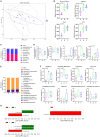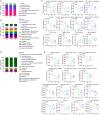Effects of Phragmites australis Shoot Remainder Silage on Growth Performance, Blood Biochemical Parameters, and Rumen Microbiota of Beef Cattle
- PMID: 35274018
- PMCID: PMC8902168
- DOI: 10.3389/fvets.2022.778654
Effects of Phragmites australis Shoot Remainder Silage on Growth Performance, Blood Biochemical Parameters, and Rumen Microbiota of Beef Cattle
Abstract
The objective of the present study was to assess the effects of replacing corn silage with Phragmites australis shoot remainder (PSR) silage on intake, growth performance, serum biochemical parameters, and rumen microbial diversity of growing-finishing beef. Fifteen Angus beef cattle with an average body weight of 253 ± 2.94 kg were randomly divided into three groups (five replicas vs. each group vs. Angus beef cattle). The three treatments were group A fed 60% PSR silage + 40% concentrate, group B fed 30% PSR silage + 30% corn silage + 40% concentrate, and group C fed 60% corn silage + 40% concentrate. The adaptation period was 15 days, and the trial period lasted for 45 days. Results showed that the ADG was significantly higher, and FCR was significantly lower both in groups A and B compared with group C. The results of serum biochemical parameters showed that the concentration of GLU was significantly lower in group B than both groups A and C. Microbial diversity results showed that the OTUs, Shannon, Chao1, and ACE indices were significantly lower in group A compared with groups B and C. At the phyla level, the relative abundances of Tenericutes and Melainabacteria had significant differences among the three groups, and the relative abundances of Papillibacter, Anaeroplasma, and Anaerovorax had significant differences among the three groups at the genus level. Additionally, Rikenellaceae was the unique biomarker among the three groups. Furthermore, the results of function prediction showed that the gene families associated with metabolism of cofactors and vitamins, cellular processes and signaling, metabolism, biosynthesis of other secondary metabolites, infectious diseases, signaling molecules and interaction, nervous system, and digestive system were significantly decreased, while lipid metabolism was dramatically increased from groups A to C at KEGG level 2. At KEGG level 3, 11 metabolic pathways were significantly influenced among the three groups. In summary, these findings indicated that PSR silage substituted the corn silage totally or partially improved the growth performance, and altered the rumen microbial composition and diversity and the corresponding change in prediction function of rumen bacteria in Angus beef cattle.
Keywords: Phragmites australis feed; beef cattle; growth performance; rumen bacterial function; rumen microbiota.
Copyright © 2022 Wang, Zeng, Zeng, Liu, Wang, Wang, Li, Wang, Feng, Huang, Yin, Huang, Zhu and Yang.
Conflict of interest statement
The authors declare that the research was conducted in the absence of any commercial or financial relationships that could be construed as a potential conflict of interest.
Figures



Similar articles
-
Whole-plant corn silage improves rumen fermentation and growth performance of beef cattle by altering rumen microbiota.Appl Microbiol Biotechnol. 2022 Jun;106(11):4187-4198. doi: 10.1007/s00253-022-11956-5. Epub 2022 May 23. Appl Microbiol Biotechnol. 2022. PMID: 35604439
-
Effect of Different Diet Formulas on Production Performance and Rumen Bacterial Diversity of Fattening Beef Cattle.Mol Biotechnol. 2025 Mar 8. doi: 10.1007/s12033-025-01402-y. Online ahead of print. Mol Biotechnol. 2025. PMID: 40057597
-
Brown midrib-3 corn silage improves digestion but not performance of growing beef steers.J Anim Sci. 2000 Nov;78(11):2957-65. doi: 10.2527/2000.78112957x. J Anim Sci. 2000. PMID: 11063322
-
Effects of Diets Combining Peanut Vine and Whole-Plant Corn Silage on Growth Performance, Meat Quality and Rumen Microbiota of Simmental Crossbred Cattle.Foods. 2023 Oct 15;12(20):3786. doi: 10.3390/foods12203786. Foods. 2023. PMID: 37893679 Free PMC article.
-
Effects of feeding growing cattle high-concentrate diets at a restricted intake on feedlot performance.J Anim Sci. 1990 Oct;68(10):3086-95. doi: 10.2527/1990.68103086x. J Anim Sci. 1990. PMID: 2254187
Cited by
-
Effects of Dietary Fucoidan Supplementation on Serum Biochemical Parameters, Small Intestinal Barrier Function, and Cecal Microbiota of Weaned Goat Kids.Animals (Basel). 2022 Jun 20;12(12):1591. doi: 10.3390/ani12121591. Animals (Basel). 2022. PMID: 35739927 Free PMC article.
-
Effects of dietary supplementation with dandelion tannins or soybean isoflavones on growth performance, antioxidant function, intestinal morphology, and microbiota composition in Wenchang chickens.Front Vet Sci. 2023 Jan 4;9:1073659. doi: 10.3389/fvets.2022.1073659. eCollection 2022. Front Vet Sci. 2023. PMID: 36686185 Free PMC article.
-
Effects of Italian ryegrass silage-based total mixed ration on rumen fermentation, growth performance, blood metabolites, and bacterial communities of growing Hanwoo heifers.J Anim Sci Technol. 2023 Sep;65(5):951-970. doi: 10.5187/jast.2023.e16. Epub 2023 Sep 30. J Anim Sci Technol. 2023. PMID: 37969342 Free PMC article.
References
-
- Baran M, Varadyova Z, Krcacmar S, Hedvabný J. The common reed (Phragmites australis) as a source of roughage in ruminant nutrition. Acta Vet Brno. (2002) 71:e445–9.
-
- Foroughi AR. Investigation of utilization of dry reed forage (Phragmites australis) in diet of fattening buffalo male calves. Iran Anim Sci Res J. (2008) 3:57–63.
-
- Kadi SA, Quendi M, Slimani M, Selmani K, Bannelier C, Berchiche M, et al. . Nutritive value of common reed (Phragmites australis) leaves for rabbits. In: Proceedings of 10th World Rabbit Congress (WRC). Sharm El-Sheikh (2012). p. 513–7.
LinkOut - more resources
Full Text Sources
Miscellaneous

